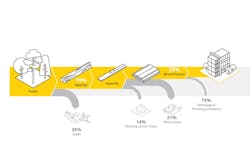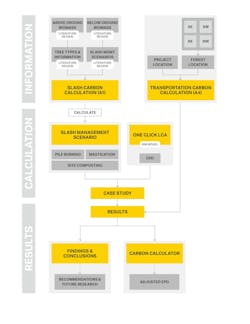Corgan offers a tool to measure mass timber’s real production carbon footprint
Global demand for wood as a building material is expected to quadruple by 2050. Demand is being driven in part by the rising popularity of mass timber for its aesthetics and eco friendliness. One of the perceived advantages of choosing mass timber panels and components for construction and renovation is their lower production-related greenhouse gas emissions vis-a-vis conventional wood products and other building materials like steel or concrete.
But the notion that producing mass timber is carbon neutral—one of its key selling points for developers and AEC firms looking to reduce a project’s carbon footprint—has come under greater scrutiny, and has led one firm, Corgan, to develop a tool that calculates CO2 from mass timber, including the harvesting and transporting processes that, according to a recent paper published by Nature, could add between 3.5 billion and 4.2 billion metric tons of GHG emissions annually to the atmosphere by 2050, the equivalent of roughly 10% of recent CO2 emissions.
Mass timber’s carbon neutrality usually means that the quantity of the wood harvested each year does not exceed the growth of wood in a large forest area. But what this analysis ignores, according to the World Resources Institute, “is that if these new wood harvests did not occur, forests would continue growing and take more carbon out of the air.”
About 35% of wood that gets harvested makes it to the building stage. The rest—bark, roots, branches, etc.— is known as slash, and this residue is often left behind.
Slash re-releases sequestered biogenic carbon that is usually not accounted for in standard life-cycle assessment studies. Slash management practices, such as piling and burning, and mulching, have varying degrees of impact on slash decomposition, according to Corgan’s research conducted by its sustainability practice Echo and research group Hugo.
Calculator aggregates many factors
The dynamic tool accounts for building size, height/floors, and tree species used to provide more accurate calculations. Designers can compare the environmental impact of using different types of mass timber—and understand the best questions to ask when helping source materials. The tool was intended to educate and empower the AEC industry, promoting transparency and better sustainable design.
In a report titled “Understanding Real CO2e Emissions in Mass Timber Production,” Corgan considers such factors as tree harvest residue, the seven species commonly used in mass timber projects in the U.S., and raw material transport. The Calculator allows designers to compare the impact of different tree species within their building scope and make lower-carbon choices.
To illustrate the practical application, a case study of a theoretical 216,000-sf, six-story office building with mass timber structural elements made from Douglas Fir and Spruce was conducted. The total volume of wood used was 115,250 cubic feet. This study found that even with the worst-case scenario for slash management, mass timber accounts for lower embodied carbon values than concrete or steel structures.
“Approximately 20% of a building’s total energy usage over its lifetime is determined long before it is even built and occupied,” said Varun Kohli, director of Corgan-Echo. “Our mass timber carbon calculation tool provides a methodology to help provide the industry with additional data for a more informed decision for Mass Timber projects, especially as the global demand for wood products continues to multiply.”
The tool is available to all and free to access.
About the Author

John Caulfield
John Caulfield is Senior Editor with Building Design + Construction Magazine.

